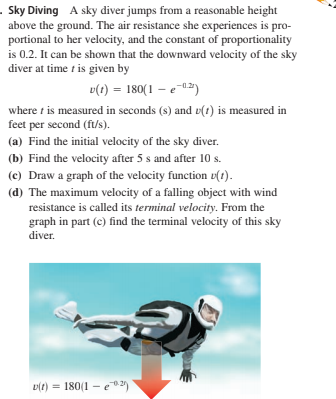. Sky Diving A sky diver jumps from a reasonable height above the ground. The air resistance she experiences is pro- portional to her velocity, and the constant of proportionality is 0.2. It can be shown that the downward velocity of the sky diver at time t is given by v(t) = 180(1 – e-0) where t is measured in seconds (s) and v(1) is measured in feet per second (ft/s). (a) Find the initial velocity of the sky diver. (b) Find the velocity after 5 s and after 10 s. (c) Draw a graph of the velocity function v(t). (d) The maximum velocity of a falling object with wind resistance is called its terminal velocity. From the graph in part (c) find the terminal velocity of this sky diver. v(t) = 180(1 - e1)
. Sky Diving A sky diver jumps from a reasonable height above the ground. The air resistance she experiences is pro- portional to her velocity, and the constant of proportionality is 0.2. It can be shown that the downward velocity of the sky diver at time t is given by v(t) = 180(1 – e-0) where t is measured in seconds (s) and v(1) is measured in feet per second (ft/s). (a) Find the initial velocity of the sky diver. (b) Find the velocity after 5 s and after 10 s. (c) Draw a graph of the velocity function v(t). (d) The maximum velocity of a falling object with wind resistance is called its terminal velocity. From the graph in part (c) find the terminal velocity of this sky diver. v(t) = 180(1 - e1)
Algebra and Trigonometry (MindTap Course List)
4th Edition
ISBN:9781305071742
Author:James Stewart, Lothar Redlin, Saleem Watson
Publisher:James Stewart, Lothar Redlin, Saleem Watson
Chapter4: Exponential And Logarithmic Functions
Section4.2: The Natural Exponential Function
Problem 25E
Related questions
Question

Transcribed Image Text:. Sky Diving A sky diver jumps from a reasonable height
above the ground. The air resistance she experiences is pro-
portional to her velocity, and the constant of proportionality
is 0.2. It can be shown that the downward velocity of the sky
diver at time t is given by
v(t) = 180(1 – e-0)
where t is measured in seconds (s) and v(1) is measured in
feet per second (ft/s).
(a) Find the initial velocity of the sky diver.
(b) Find the velocity after 5 s and after 10 s.
(c) Draw a graph of the velocity function v(t).
(d) The maximum velocity of a falling object with wind
resistance is called its terminal velocity. From the
graph in part (c) find the terminal velocity of this sky
diver.
v(t) = 180(1 - e1)
Expert Solution
This question has been solved!
Explore an expertly crafted, step-by-step solution for a thorough understanding of key concepts.
This is a popular solution!
Trending now
This is a popular solution!
Step by step
Solved in 4 steps with 1 images

Recommended textbooks for you

Algebra and Trigonometry (MindTap Course List)
Algebra
ISBN:
9781305071742
Author:
James Stewart, Lothar Redlin, Saleem Watson
Publisher:
Cengage Learning

Algebra & Trigonometry with Analytic Geometry
Algebra
ISBN:
9781133382119
Author:
Swokowski
Publisher:
Cengage

Functions and Change: A Modeling Approach to Coll…
Algebra
ISBN:
9781337111348
Author:
Bruce Crauder, Benny Evans, Alan Noell
Publisher:
Cengage Learning

Algebra and Trigonometry (MindTap Course List)
Algebra
ISBN:
9781305071742
Author:
James Stewart, Lothar Redlin, Saleem Watson
Publisher:
Cengage Learning

Algebra & Trigonometry with Analytic Geometry
Algebra
ISBN:
9781133382119
Author:
Swokowski
Publisher:
Cengage

Functions and Change: A Modeling Approach to Coll…
Algebra
ISBN:
9781337111348
Author:
Bruce Crauder, Benny Evans, Alan Noell
Publisher:
Cengage Learning

College Algebra
Algebra
ISBN:
9781305115545
Author:
James Stewart, Lothar Redlin, Saleem Watson
Publisher:
Cengage Learning